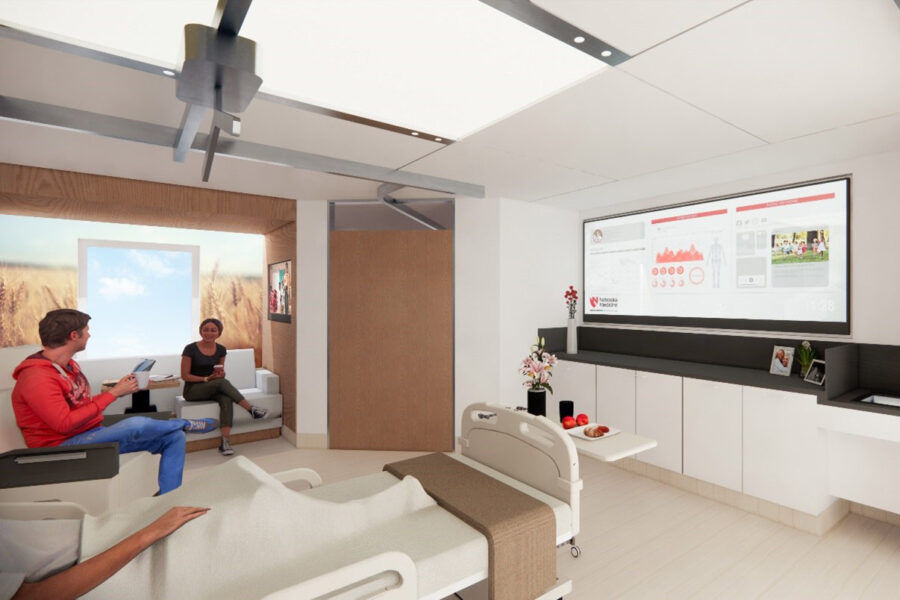The work to shape the future of inpatient care is happening now. In fact, anyone near level six of University Tower at Nebraska Medical Center may even hear and feel it.
The actual noise aside — the real noise to focus on — is the teamwork and innovation being put into the Innovation Design Unit, which is scheduled to open in January 2025.
People may be asking, “What is the Innovation Design Unit?” “Who will it treat?” “How will it be different from other inpatient units?”
The overall purposes of the Innovation Design Unit:
- Provide an environment to work, practice, educate and staff more efficiently.
- Optimize team-based care and communication.
- Enhance quality, safety and clinical outcomes.
- Improve the lives of our physicians, staff, learners and care providers.
- Lower the cost of care.
- Provide a safe, inviting environment committed to equity of care.
“The Innovation Design Unit is our opportunity to transform the way we deliver care,” said Kara Tomlinson, executive director of the Innovation Design Unit. “It will help us in proactively shaping a health care system that can anticipate and meet the evolving needs of our patients. It will be a holistic transformation where innovation is the driving force behind a people-centered, highly reliable, high-value system of care.
“By establishing an Innovation Design Unit, we will reimagine health care from the ground up and use this as a framework to best position us for the future and the investment into Project NExT. We will have the opportunity to test and try things ahead of time. How cool is that?”
The Innovation Design Unit, located on level six of University Tower, is the first phase of Project NExT – now known as Project Health: Building the Healthiest Nebraska. The unit will be an active patient care environment intended to design, test and validate new models of care, innovative technology and facility design. The unit will focus on long-term benefits, sustainability and the development of best practices that will benefit our health system and the community.
There will be 17 patient rooms in this unit divided into zones. Each zone is intended to test various room designs, equipment or processes. The primary patients receiving care in the Innovation Design Unit will be adult medical-surgical. The levels of care include medical-surgical, progressive and eventually intensive care. Using the feedback from hundreds of colleagues, initial projects that have been prioritized include the integration of virtual nursing into a team-based staffing model and the implementation of new systems such as an interactive patient experience platform and real-time location system. In a surge capacity or pandemic situation, rooms can be modified to accommodate double occupancy.
“The IDU will be trialing an acuity adaptable care environment,” said Michelle Schulte, nurse manager of the Innovation Design Unit. “If a patient’s condition progresses and they move from a medical-surgical level of care to a progressive level of care, the patient will be able to stay in their own room, and the resources will adjust to meet the needs of the patient. Literature has shown that this model of care decreases administrative hours from clinicians, decreases risks caused by handoffs and improves a patient’s and family’s experience by staying in the same room.”
Adjacent to the unit will be a design/testing area, commonly referred to as the “bridge space.” As new pilots or projects arise, this zone will prioritize, develop, test and evaluate these innovations. Teams consisting of scientists, researchers, clinicians and industry partners, will collaborate in this space, ensuring rapid implementation and evaluation to ensure the most effective and efficient changes are shared across the organization.

Phase one will take place this spring. This includes the design and building of new IT systems and operations workflows for the Innovation Design Unit and complete hiring of the core unit staff members. Phase two will occur this summer through fall, when the aforementioned systems and workflows will be fully integrated so that simulations and testing can occur to refine optimization of the unit. Lastly, phase three will be this winter and will include the final technical and workflow dress rehearsals as preparations are made to welcome the first patient to the unit.
The Innovation Design Unit workgroups have been taking feedback from front-line staff on everything from the physical space design to delivery of care.
“Workstreams have been meeting for months, and one reoccurring theme has been evident throughout –a focus on people,” Schulte said. “’How will this space impact people who encounter this unit?’ ‘How will this improve the patient’s experience?’ and ‘How will this improve safety, workflow and teamwork amongst the workforce?’”
“The vision of the IDU is to lead the evolution of health care with innovations that enhance the well-being of all,” said Calli Sibilia, project manager of the Innovation Design Unit. “It supports the Nebraska Medicine mission to lead the world in how we care for patients and educate health care professionals of the future.”
Tomlinson added, “This unit will facilitate rapid insights that we can share throughout the health system, the community, the state and beyond.”
“We are constantly asking ourselves, ‘Is this innovative?’ ‘Does this push the envelope?’ ‘How are we transforming health care with this solution, product or staffing model?’” Schulte said. “We cannot think about what is available now. We must think about what might be out there in 10-plus years.”

I love this. So smart to try a few things out to find out the best ways to do things before building our new hospital.
I look forward to seeing what is discovered!
It is encouraging to see the progress towards a better future for patients and clinicians through the Innovation Design Unit.